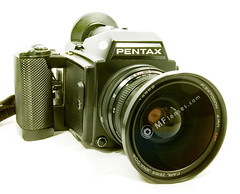Pentax 645
The Pentax 645 is a medium format SLR camera, made from 1984. It takes 15 pictures nominally 6x4.5 cm, on 120 roll film, or 30 on 220 film, and it can also use 70 mm film, which gives approximately 90 frames per roll. It has a built-in motor drive and a low-profile prism viewfinder with built-in dioptric correction. The camera looks somewhat like the Mamiya M645 E (but predates it by several years, and also offers more exposure options than any of the manual-focus M645 cameras).
Film is loaded onto holders (each being essentially a pair of spool holders and a pressure plate, mounted on a removable camera back plate). A holder, once loaded, is inserted into the back of the camera body and fastened in by turning a key built into the holder. Holders cannot be exchanged mid-roll.
The camera has several automatic exposure modes. Most exposure controls are accessed via menus in a liquid-crystal display (LCD) on the top, to the right of the eyepiece. The menus are operated with buttons (on the left of the VF eyepiece) to select parameters such as exposure mode, ISO speed and exposure compensation level, and up/down navigation buttons to the right of the LCD. This is very different from the controls on the Mamiya medium-format SLR cameras of the same time.
The camera requires six AA batteries, loaded in the grip on the right hand side, to power all camera functions. There is also a lithium battery fitted in the base of the camera, which serves to maintain the electronic memories. There is no battery check as such; the manual suggests that the performance of the power winder is affected by low batteries before other camera functions. The grip is removable, but this is mostly for convenience of loading the batteries; the grip is essential for use of the camera, carrying the batteries, the main on-off switch and the shutter release button.
Specifications
Camera type: 6x4.5 cm SLR (actual image frame 56x41.5 mm)
Lens mount: Pentax 645 A bayonet
Standard lens: 75 mm f/2.8
Shutter:
- Vertical-running focal-plane shutter with cloth curtains. Speeds 15 seconds - 1/1000 second, plus 'B'.
- Camera also accepts leaf-shutter lenses.
- Synchronised for flash via a hot shoe on top of the prism and a PC socket; X-synchronisation at 1/60 second or slower.
- Shutter release button on grip; threaded for a cable release.
- No delayed action.
Metering and exposure:
- Through-the-lens, centre-weighted metering with ISO range 6-6400 in 1/3 stop increments
- Several exposure-control modes:
- Shutter speed priority automatic
- Aperture priority automatic
- Programmed automatic
- Manual
- TTL metered flash
- Programmed automatic flash
- Special mode for leaf-shutter lenses
Viewfinder:
- Fixed low-profile prism viewfinder; telescopic eyepiece with bilt-in dioptric adjustment.
- Interchangeable focusing screens; standard screen with microprism and split-prism rangefinder focusing aids.
- LED indication of exposure settings and warnings.
Film advance:
- Built-in power winder
- Manual film winding knob can be attached (on the right of the body), but is recommended only as an emergencey measure in the event of battery failure.
Other features:
- ¼ inch tripod bushes on the base and on the left-hand side of the body.
- Depth-of-field preview lever on the right of the body.

|
| image by De MAF (Image rights) |
Links
- User's Manual on Pentax Imaging website (rather poor pdf file; when accessed April 2011, appeared to be missing four pages)
- Review on Pentax Forums
Bibliography
- Lewis, Gordon, ed. The History of the Japanese Camera. Rochester, N.Y.: George Eastman House, International Museum of Photography & Film, 1991. ISBN 0-935398-17-1 (paper), 0-935398-16-3 (hard). P.176.
- Sugiyama, Kōichi (杉山浩一); Naoi, Hiroaki (直井浩明); Bullock, John R. The Collector's Guide to Japanese Cameras. 国産カメラ図鑑 (Kokusan kamera zukan). Tokyo: Asahi Sonorama, 1985. ISBN 4-257-03187-5. Item 2055.
| Japan Camera Grand Prix | |
|---|---|
| Camera of the year
1984: Nikon FA | 1985: Minolta α-7000 | 1986: Canon T90 | 1987: Canon EOS 650 | 1988: Kyocera Samurai | 1989: Nikon F4 | 1990: Canon EOS 10 | 1991: Contax RTS III | 1992: Pentax Z-1 | 1993: Canon EOS 5 | 1994: Minolta α-707si | 1995: Contax G1 | 1996: Minolta TC-1 | 1997: Nikon F5 | 1998: Pentax 645N | 1999: Minolta α-9 | 2000: Canon EOS-1V | 2001: Minolta α-7 | 2002: Canon EOS-1D | 2003: Canon EOS-1Ds | 2004: Nikon D70 | 2005: Konica Minolta α-7 Digital | 2006: Nikon D200 | 2007: Pentax K10D | 2008: Nikon D3 | 2009: Canon EOS 5D Mark II | 2010: Olympus Pen E-P1 | 2011: Pentax 645D | 2012: Nikon D800 | 2013: Sony DSC-RX1 | 2014: Nikon Df | 2015: Canon EOS 7D Mark II | 2016: Sony α7R II | 2017: Olympus OM-D E-M1 Mark II | 2018: Sony α9 | 2019: Lumix S1R | 2020: Sony α7R IV | 2021: Sony α1 | 2022: Nikon Z9 | 2023: Sony α7R V Special Prize Editor | |
